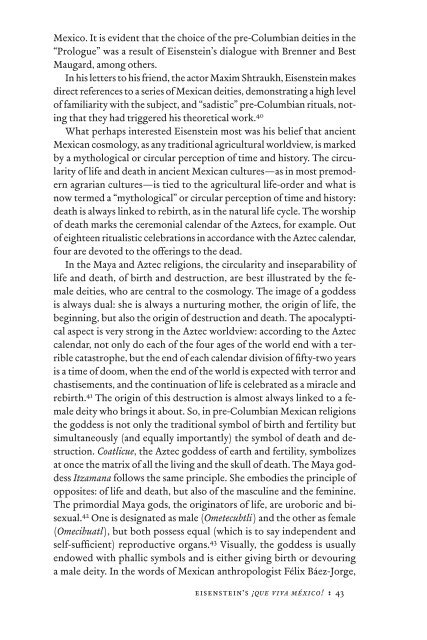In Excess: Sergei Eisentein's Mexico - Cineclub
In Excess: Sergei Eisentein's Mexico - Cineclub
In Excess: Sergei Eisentein's Mexico - Cineclub
You also want an ePaper? Increase the reach of your titles
YUMPU automatically turns print PDFs into web optimized ePapers that Google loves.
<strong>Mexico</strong>. It is evident that the choice of the pre-Columbian deities in the<br />
“Prologue” was a result of Eisenstein’s dialogue with Brenner and Best<br />
Maugard, among others.<br />
<strong>In</strong> his letters to his friend, the actor Maxim Shtraukh, Eisenstein makes<br />
direct references to a series of Mexican deities, demonstrating a high level<br />
of familiarity with the subject, and “sadistic” pre-Columbian rituals, noting<br />
that they had triggered his theoretical work. 40<br />
What perhaps interested Eisenstein most was his belief that ancient<br />
Mexican cosmology, as any traditional agricultural worldview, is marked<br />
by a mythological or circular perception of time and history. The circularity<br />
of life and death in ancient Mexican cultures—as in most premodern<br />
agrarian cultures—is tied to the agricultural life-order and what is<br />
now termed a “mythological” or circular perception of time and history:<br />
death is always linked to rebirth, as in the natural life cycle. The worship<br />
of death marks the ceremonial calendar of the Aztecs, for example. Out<br />
of eighteen ritualistic celebrations in accordance with the Aztec calendar,<br />
four are devoted to the offerings to the dead.<br />
<strong>In</strong> the Maya and Aztec religions, the circularity and inseparability of<br />
life and death, of birth and destruction, are best illustrated by the female<br />
deities, who are central to the cosmology. The image of a goddess<br />
is always dual: she is always a nurturing mother, the origin of life, the<br />
beginning, but also the origin of destruction and death. The apocalyptical<br />
aspect is very strong in the Aztec worldview: according to the Aztec<br />
calendar, not only do each of the four ages of the world end with a terrible<br />
catastrophe, but the end of each calendar division of fi fty-two years<br />
is a time of doom, when the end of the world is expected with terror and<br />
chastisements, and the continuation of life is celebrated as a miracle and<br />
rebirth. 41 The origin of this destruction is almost always linked to a female<br />
deity who brings it about. So, in pre-Columbian Mexican religions<br />
the goddess is not only the traditional symbol of birth and fertility but<br />
simultaneously (and equally importantly) the symbol of death and destruction.<br />
Coatlicue, the Aztec goddess of earth and fertility, symbolizes<br />
at once the matrix of all the living and the skull of death. The Maya goddess<br />
Itzamana follows the same principle. She embodies the principle of<br />
opposites: of life and death, but also of the masculine and the feminine.<br />
The primordial Maya gods, the originators of life, are uroboric and bisexual.<br />
42 One is designated as male (Ometecuhtli ) and the other as female<br />
(Omecihuatl ), but both possess equal (which is to say independent and<br />
self-suffi cient) reproductive organs. 43 Visually, the goddess is usually<br />
endowed with phallic symbols and is either giving birth or devouring<br />
a male deity. <strong>In</strong> the words of Mexican anthropologist Félix Báez-Jorge,<br />
eisenstein’s ¡que viva méxico! : 43


